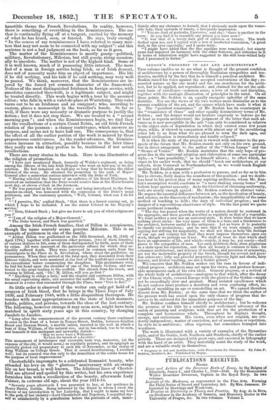SEDDON'S PROGRESS IN ART AND ARCHITECTURE.*
Tars volume enables us to see what is thought of the present condition of architecture by a person of thoroughly Ruskinian sympathies and ten- dencies, modified by the fact that he is himself a practical architect Mr. Ruskin raised his voice against the accepted conventions of the day ; re- asserted nature as the one model and the one storehouse for the archi- tect, but to be applied, not reproduced ; and claimed for the art the ordi- nary basis of excellence—common sense, a love of truth and discipline. together with the analogic illustration of principles in the mind. On all these points Mr. Seddon is an equally energetic upholder of the same doctrine. Nor are the views of the two writers more dissimilar as to the present condition of the art, and the causes which have made it what it is. The "pestilent renaissance" of Mr. Ruskin has its counterpart in the "renaissance of chaos" and other equally denunciatory terms of Mr. Seddon ; and the former would not hesitate expressly to indorse (so far at least as regards architecture) the judgment of the latter that such ad- vance as is now perceptible in the arts " can only be considered as relative to the abject state of degradation in which they existed some few years since, while, if viewed in comparison with almost any of the mouldering relics left to us from what we are pleased to term the dark ages, our boasted civilization is immediately and totally eclipsed."
It is when the state of the present is viewed with reference to the pro- spects of the future that Mr. Seddon stands not only on his own ground, but in direct antagonism to the author of the "Seven Lamps" and the " Stones of Venice." Mr. Ruskin maintains that the only hope of pro- gress lies in the universal adoption and elaboration of some one particular style,—a " bare possibility," as he himself allows ; to effect which, he urges in his earlier work, that we should "teach our architecture at our schools, from Cornwall to Northumberland, as we would teach English spelling and English grammar."
Mr. Seddon, as a man with a profession to pursue, and so far as in him lies to elevate, flatly denies the soundness of this position : and we doubt- less hear in his protest that of many aspiring architects, whom Mr. Rus- kin's assumption would condemn to "a mere shaking among bones" and forlorn hope against necessity. As to the likelihood of obtaining uniformity, both are nearly enough agreed : Mr. Seddon contests its abstract value. He argues the essential difference between art, as the inculcation of beauty, and science, as the discovery of mechanism • the inapplicability of the same method of teaching to both ; the duty of individual progress ; and the dangers of a superstitious observance of style. On the last point we quote some pertinent remarks.
" The day has passed when the works of a nation should be reckoned in the aggregate, and their growth described as regularly as that of a vegetable. We want neither a new nor an universal style. It were better that we knew nothing about styles : the very name of them is a bane and a hinderance to the architect, however useful to the antiquary. Let us leave it to posterity to classify our productions ; and be sure that if we work simply, neither copying nor striving for singularity, we shall not then so belie the feelings of our age and country but that they must impress themselves upon our work, though we perhaps see it not. We shall at least do that which shall have an appearance of life, and which—rudely, it may be, yet surely—shall pierce to the sympathies of men. Let each architect, then, shun plagiarism as a stain upon his reputation, and then all beauty is common to him for columnar architecture, and delicacy of moulding, and precision of symmetry, are not the inalienable property of the Greek, though his several and pecu- liar orders are ; lofty and graceful proportion, vigorous light and shade, fairy tracery, and fretted vaulting, are not a Gothic patent." We conceive that Mr. Seddon makes out his case in favour of indi- vidual progress : architects may act upon his views, and produce honour- able monuments each of his own ideal. General progress, or a revival of the whole body of architecture—analogous to that which, after the decay of the Classic style, covered Europe with the glories of the Gothic—might yet be exceedingly slow and gradual. Many isolated excellences which do not coalesce must produce a desultory and even confusing effect, in- capable of moulding an ago or remodelling an art. We cannot therefore dissent from Mr. Ruskin ; at the same time that we think the author of the present work has seized upon the only chance of progress that de- serves to be enforced for the immediate purposes of the day.
Mr. Seddon confines himself chiefly to architecture ; but he redeems the promise of his title by a sensible and well-timed advocacy of the union of painting and sculpture with that art for the production of a complete and harmonious whole. Throughout he displays thought, energy, and enthusiasm. His views, even when not original, are evi- dently independent; matter of conviction, not of assumption or repetition. In style he is ambitious ; often vigorous, but sometimes betrayed into wordiness.
The work is illustrated with a variety of examples of the Byzantine style, and of the Gothic, both Northern and Southern, chiefly of the earlier periods. These are designed with great care, and executed in lithography with the hand of an artist. They materially assist the study of the work, and are a valuable study in themselves.
• Progress in Art and Architecture, with Precedents for Ornament. By John P. Seddon, Architect, &c. Published by Bogue.


































 Previous page
Previous page